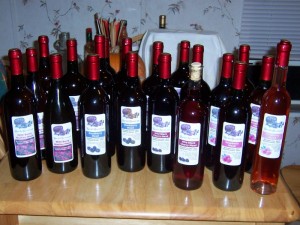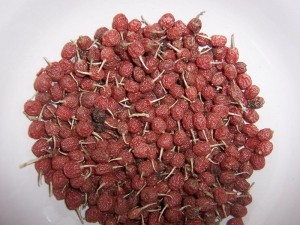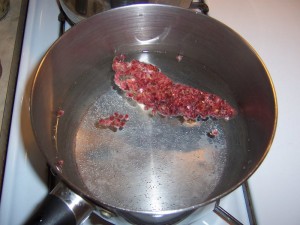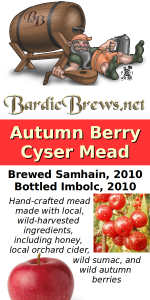Please feel free to distribute this flyer wherever you think it might be useful:
Month: October 2010
Preregistration Now Available!
Preregistration is now available for the From Alcohol To Alchemy: The Lore, Craft, And Nutrition Of Mead event at the Urban Farm Fermentory on Tuesday, November 16. There are 2 registration packages available.
If you’d like to register for the full Get Your Gear, Brew Your Mead package, including admission, ingredients, and all brewing gear so you can take home your first batch of fermenting mead, register here. There are only 12 premium seats available, so hurry!
If you’d like to register for general admission, to see the workshop and hear the talk by Daniel Vitalis, then register here.
Seating is limited, so register soon! Hope to see you there.
Samhain Harvest
Had some good bottling sessions as of late:
Plus, a week or so ago I did a mini-bottling session:
Blessings and gratitude for the bounty!
Next out of the carboy: Elderberry Mead, followed by Dry Vanilla Peach and Mabon Mugwort, followed by Autumn Berry Cyser. The cooler weather has slowed down fermentation time for sure.
Next up: thinking a rose hip mead is in order. Harper did one last year and it was UNbelievable, like spring in a bottle. Gonna see if I can harvest some wild rose hips in the next few days….
Autumn Berry Cyser
So all summer long I’ve been thinking about the cyser (or cysers) I’d do in the fall. Well, fall is here in full swing, and a friend just happened to turn me on to some Autumn Berries (also called Autumn Olives):
The autumn olive, elaegnus umbellate, is native to China, Japan, and Korea and was introduced to the United States in the mid 1800s. It is a deciduous tree or shrub that grows up to 20 feet high and 30 feet wide. In the 1950s it was promoted throughout the states to control erosion, and as a wildlife habitat. It was once used to help refoliate areas that were stripped bare due to mining and other environmental disturbances. Now, it is considered an alien invasive species.
He gave them to me still on the branches, so I had a bit of food processing time as I picked the berries off. Once picked and rinsed, I had probably less than a cup of the berries:
Turns out Autumn Berries are quite healthy also:
With as much as 15-18 times the amount of lycopene found in tomatoes, autumn berries are being touted as one of the best cancer preventative natural medicines. (The autumn berry has 40 to 50 mg/100g of lycopene compared to 3 mg/100g for a fresh raw tomato and 10 mg/100g for canned whole tomatoes.) The carotenoid is thought to be helpful in the prevention of heart disease, muscular degenerative disease, bladder, breast, gastrointestinal, cervix, mouth, throat, lung, prostate and skin cancers. The berries also contain vitamins A,C, E, flavonoids and essential fatty acids.
I thought these would go nicely in a cyser with the local apples, since both are quite ripe just now. Of course, to make cyser you need cider, so I went around the corner from my home and picked up 3 gallons of fresh, unprocessed, unfiltered, non-UV treated cider from my local orchard. I left them a 3 gallon carboy, which they held until their next pressing day which was yesterday.
Since I’m using cider, I decided to make a small amount of sumac tea, so I filled a saucepan half full of water, added a sumac drupe, brought it to a boil and let it steep for a couple hours until the liquid was a lovely pink color. Here’s the beginning of the infusion process:
Once done, I let it cool off some, strained the tea into the high speed blender with the autumn berries, and let it whizz for a couple minutes. Then I poured the puree into the pot, that I’d put about 2 gallons of cider and about 1/2 gallon of honey.
I mixed everything up well, heating it slightly up to about 85 degrees, so everything would dissolve. I then took a hydrometer reading and was showing about 13% potential alcohol. I then added a bit more honey until I reached a 15% alcohol potential.
I chose this number because I want a bit of a dry cyser. I’ll be doing more hydrometer readings from now on, simply because I think my meads have been great but a bit too sweet. I want a better understanding of how to “tweak” this parameter to achieve the desired sweet/dry end result.
For now, my stakes in the ground are that 15% potential will produce a reasonably dry mead; 20% will produce a reasonably sweet mead. 17.5% (what Harper generally recommends if you aren’t sure) is a great middle ground.
End result is interesting, it looks like cider with a hint of pink to it (from the sumac tea and the autumn berries):
Looking forward to trying this one, though I’m not sure how the aging process will go. Time will tell!
UPDATE:
Finally racked the autumn berry cyser. Fermantation slowed down with the cooler seasons, plus I let it go a bit longer than usual (12 weeks). Final alcohol potential is under 1% but we’ll call it good at 1%. This means the cyser is 14% alcohol. Taste is exquisite, tartness from the cider, very little remaining sweetness. Very nice!
Here is the label for this batch:
This mead won First Place at the first annual Maine Pagan Meader’s Cup, for “Best Dry Mead.” It’s a private event, and was my first ever mead award! :-)
Mead Workshop Details
BardicBrews.net presents:
From Alcohol To Alchemy:
The Lore, Craft, and Nutrition of Mead
Tuesday, November 16, 7-10pm
At the Urban Farm Fermentory
200 Anderson St. – Bay 4
Portland, ME 04101
207-653-7406
General Admission, $35
42 spots available ($45 at the door)
– or –
Get Your Gear, Brew Your Mead, $125
only 12 spots available, including:
- Admission ($35 value)
- Brewing Kit ($60 value) — you keep all the brewing equipment
- Ingredient Kit ($40 value) — your first batch will produce 10-12 bottles of mead for you to enjoy
- Hand-holding: consult with James Lindenschmidt in advance to plan your first batch of mead, and brew onsite with guidance during workshop
- You keep everything, you will take home the 3 gallon carboy full of what will become mead in a few weeks (about 10-12 bottles).
Workshop includes:
- Short talk on Mead Lore by James Lindenschmidt of www.BardicBrews.net
- One-Hour lecture on the Nutrition and Alchemy of Mead by Daniel Vitalis
- Meadmaking Craft workshop with James Lindenschmidt, where you will see several batches of mead being made, and have the opportunity to brew your own first batch of mead
Also Available At The Workshop:
Brewing Equipment Kit
Optional, available at event
$60 includes:
- 3 gallon glass carboy
- funnel
- stopper
- airlock
- siphon hose
- hydrometer
Ingredient Kit
Optional, available at event
$40 includes:
- 1 gallon of honey
- 1 packet of brewing yeast
Preregistration will begin soon. Watch this space! In the meantime if you require more information, contact us.








